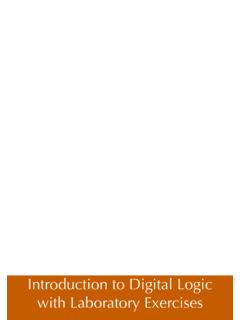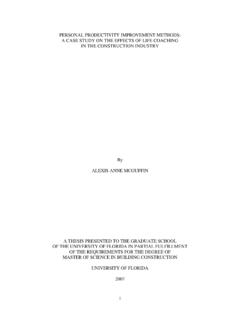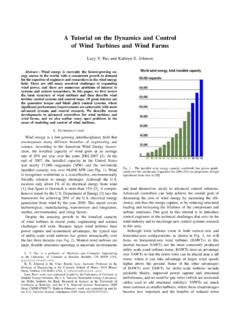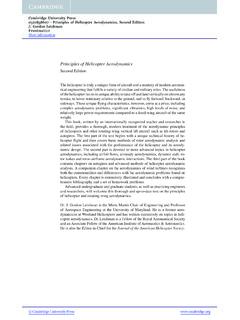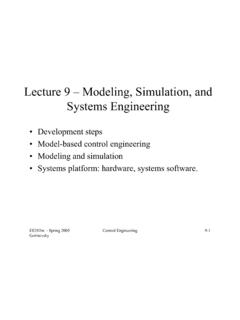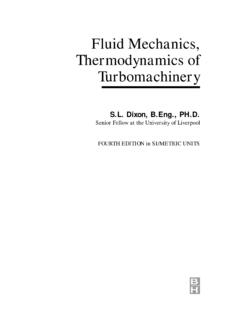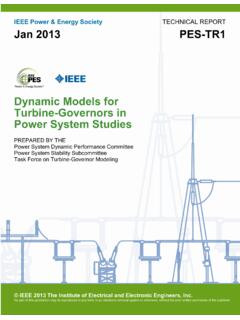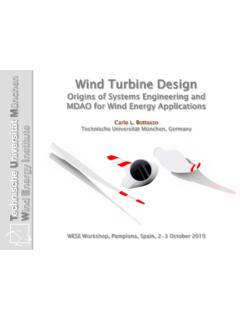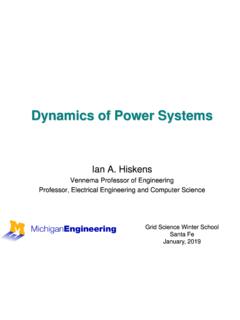Transcription of Nonlinear Control of a Wind Turbine
1 University of Florida | Journal of Undergraduate Research | Volume 13, Issue 2 | Spring 2012 1 Nonlinear Control of a wind Turbine Andrew Buckspan College of Engineering, University of Florida wind power is a rapidly growing source of alternative energy that presents numerous Control problems. One of these problems is that the Turbine dynamics are Nonlinear and contain states that are difficult or not possible to measure. A Control strategy is developed in this study to track a desired angular velocity despite uncertainties in the dynamics . The Control scheme uses a dynamic neural network to identify unknown parameters and a neural network feedforward controller augmented by a robust integral of the sign of the error (RISE) feedback term.
2 Performance is verified through numerical simulations. INTRODUCTION wind energy is presently one of the fastest growing sources of alternative energy, providing a clean, emission-free alternative to fossil fuels. In the last two years, total worldwide installed capacity has exceeded 150 GW [1]. Additionally, the United States Department of Energy has proposed a comprehensive plan for wind energy to provide 20% of electrical energy by 2030 [2]. wind turbines are classified as either horizontal wind turbines (HAWTs) or vertical axis wind turbines (VAWTs). While VAWTs are able to more efficiently capture power from wind that frequently shifts directions, HAWTs are typically used for large-scale turbines [3].
3 HAWTs have an advantage in that the entire rotor assembly is placed high above the ground, where wind speeds are typically faster. Additionally, VAWTs experience higher mechanical stresses due to the asymmetry of the forces exerted on the blades [4]. These attributes have led HAWTs to become the industry standard configuration, and is the configuration considered in this study. Generally, three regions of operation are identified based on wind speed and mechanical properties of a specific Turbine [3]. In Region I, the wind speed is below a minimum level required to overcome mechanical and electrical losses in the Turbine , and the Turbine is not allowed to operate.
4 In Region II, the wind speed is above minimum, but it is not high enough to cause the Turbine to operate above its maximum rated capacity. In Region II, Control can be achieved by applying a brake torque to the Turbine drive shaft to achieve a desired rotational velocity. At the higher end of Region II, this brake torque can saturate, in which case the rotor blades are tilted to maintain the desired rotational velocity. In this study, it is assumed that the wind velocity is not high enough to cause saturation of the brake torque, so Control of the blade pitch angle is not considered. In Region III, the wind speed is above a maximum rated speed, and the rotor blades are pitched to shed excess power.
5 Since wind turbines usually operate in Region II, this region will be considered in this study. Control in Region II is significantly complicated by the fact that the Turbine dynamics are Nonlinear and include unknown and unmeasurable terms. These unmeasurable terms include the torque exerted on the Turbine by the wind , the power captured by the Turbine at the blades, and the coefficient of performance of the Turbine . A number of Control strategies have been proposed to deal with these problems. One approach [5] involves linearization of the Turbine dynamics , and the application of a typical PID controller; however, the linear assumption can lead to reduced performance and reliability.
6 An improvement on the linearized PID method is sliding mode Control [6]. This method provides better tracking of a desired rotational velocity than controllers developed for linear dynamics . However, sliding mode Control methods, such as [6], assume that the power captured by the Turbine is measurable, which is generally not the case. In [7], the approach used to compensate for the Nonlinear dynamics is an adaptive Control algorithm. However, the controller in [7] is developed under the assumption that the power captured by the Turbine can be measured based on the electrical power generated by the Turbine . This is not the case in practice, as there exists variable loss in the conversion of mechanical energy captured at the blades to electrical energy out of the generator.
7 In [3], a feedback controller is presented for a specific Turbine . While this controller achieves good results, it assumes a priori knowledge of optimum values for the unknown Turbine parameters. However, these values are specific to the Turbine the controller is implemented on and realistically change based on Turbine geometry and mechanical parameters. This approach is therefore difficult to adapt to new turbines. Methods for estimating the unknown parameters have been proposed. One such method, given in [8], uses a least-squares Kalman filter to estimate the unknown aerodynamic torque. Again, this method assumes optimum values for unknown Turbine parameters are known.
8 ANDREW BUCKSPAN University of Florida | Journal of Undergraduate Research | Volume 13, Issue 2 | Spring 2012 2 The most relevant work to the controller developed in this study is found in [9] and [10]. In [9], a robust Control strategy was used to estimate the unknown coefficient of performance and track a desired trajectory. However, this controller was shown to converge very slowly. A robust controller was also developed in [10] and was combined with a numerical extremum seeking algorithm to estimate the unknown coefficient of performance. However, this numerical method is prone to instability and possibly large estimation error. This study builds upon the Control strategies developed in [9] and [10] by using a robust integral of the sign of the error (RISE) feedback term along with a dynamic neural network feedforward term in the controller.
9 Additionally, the dynamic neural network is used to estimate the unknown coefficient of performance. This study focuses on developing a controller that can track a desired Turbine rotational speed despite the unobservable coefficient of performance term. A controller developed in [11] uses a robust Control scheme with a multi-layer neural network to track a desired trajectory despite Nonlinear system uncertainties. This study will focus on adapting the Control strategy developed in [11] for use in a wind Turbine . dynamics The wind Turbine blades are characterized by two controllable parameters. One parameter is the tip-speed ratio, , which is the ratio of the linear speed at the tip of the Turbine blades to the wind speed.
10 The tip-speed ratio is defined as (1) where (t) is the rotational speed of the Turbine blades, R is the radius of the circle swept by the blades, and v(t) is the wind speed. These quantities are all assumed to be known or measurable, and hence the tip-speed ratio is measurable. The tip-speed ratio can be directly controlled by controlling the rotational speed of the Turbine , which will be discussed. The second of controllable parameter is the blade pitch angle, . For simplicity, the subsequent analysis assumes that each of the Turbine blades is pitched to the same angle. Furthermore, the blade pitch angle will not be controlled, so the pitch angle for each blade will be considered constant.
